The Frontline of Informatization in Higher Education
MEET Kick-Off Symposium
MEET held a symposium “The Frontline of Informatization in Higher Education” in concert with Microsoft Japan on June 14, 2006, in commemoration of opening our chair. MEET invited five front-runners in Japan and abroad in researching and promoting of informatization in higher education to get in touch with the latest trends.
The Use and Challenges of Information Technology in Education
Aya Yoshida, Professor,National Institute of Multimedia Education
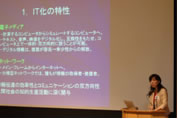 The use of information technology (IT) for education can be categorized into the following three phases. The first phase is the implementation of IT in universities. The second is the transformation of educational contents by utilizing IT. The use of IT in classroom comes the third. The use of IT is supposed to start from the first phase and then move to the second and third. In Japan, IT is widely adopted on the first and second levels according to our recent research about higher educational institutions.
The use of information technology (IT) for education can be categorized into the following three phases. The first phase is the implementation of IT in universities. The second is the transformation of educational contents by utilizing IT. The use of IT in classroom comes the third. The use of IT is supposed to start from the first phase and then move to the second and third. In Japan, IT is widely adopted on the first and second levels according to our recent research about higher educational institutions.
This increasing use of IT in the field of education is related to some characteristics of IT. Due to its highly efficient transfer of information and its interactive communication capability, alternative efficiency is achieved. This alternative efficiency, however, cannot be observed in the third phase. This situation typically affects e-learning, which spreads only slowly in Japan. The commitment of organizations involving also plays a key role in the progress of IT. The level of organizational involvement can vary depending on the existence of school policy. Our research on domestic educational institutions shows that most universities have finalized their policy on infrastructures, not the least of which on education.
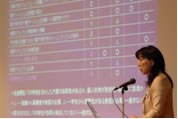 As for the use of IT on the third stage, not only the issue of alternative efficiency but the lack of comprehensive data to determine if IT should contribute to education is also a problem. There are useful research results published in US for this issue. MEET eagerly awaits research output through which the use of IT in universities in Japan would make a progress.
As for the use of IT on the third stage, not only the issue of alternative efficiency but the lack of comprehensive data to determine if IT should contribute to education is also a problem. There are useful research results published in US for this issue. MEET eagerly awaits research output through which the use of IT in universities in Japan would make a progress.
Effective Operation Method to Utilize Video Contents for e-Learning
Yasushi Ito, CTO,
Business Breakthrough, Inc.
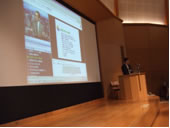 Business Breakthrough, Inc. offers human development solutions through management training programs to develop business leaders who can be successful across the globe. We have become the first graduate school in Japan where students can study for MBA via distance learning.
Business Breakthrough, Inc. offers human development solutions through management training programs to develop business leaders who can be successful across the globe. We have become the first graduate school in Japan where students can study for MBA via distance learning.
By incorporating broadband technologies, our company delivers these training programs. Technically it is possible to make series of lectures viewable at a time; however, we schedule the timing of delivering classes, for example, the first lecture during a certain week, and the second lecture during the following week. Doing so helps lecturers to give coursework to students alongside courses. Students then engage in in-depth discussions. After the discussions, reading materials, such as textbooks and reference books, are presented. Students can develop and refine their thoughts with further reading. They summarize their ideas in an essay as a final exam. E-learning often faces the issue of attendance rate. Random display of alphabet and numerical strings during streaming videos must be followed by students’ response. They must type the same keys so that we can check attendance.
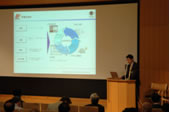 As for the effectiveness of learning, the correlation has been recognized between each student’s grade and the number of statements made during discussions. This type of educational methodology is particularly effective for those who have professional experiences and are willing to invest themselves in learning. In the future, we will offer training to high school students in the same style.
As for the effectiveness of learning, the correlation has been recognized between each student’s grade and the number of statements made during discussions. This type of educational methodology is particularly effective for those who have professional experiences and are willing to invest themselves in learning. In the future, we will offer training to high school students in the same style.
Classroom Presenter Using the TabletPC to support Classroom Interaction
Dr. Richard Anderson, Professor,
Department of Computer Science and Engineering, University of Washington
 My research interest is how education will change when each student carries a computer device and has them available to use in class. "Classroom Presenter", which I am going to explain, is an application for TabletPC developed by University of Washington. With this system, students draw or write about a certain topic given by a teacher with a pen-based computer. Their input is sent to a teacher's computer and immediately made ready to be projected in a classroom. This is a new channel of communication. Students, professors, and lecturers can communicate much more easily. This system allows lecturers to measure how deep an understading students have of the topics. In this sense, it is an extremely effective tool.
My research interest is how education will change when each student carries a computer device and has them available to use in class. "Classroom Presenter", which I am going to explain, is an application for TabletPC developed by University of Washington. With this system, students draw or write about a certain topic given by a teacher with a pen-based computer. Their input is sent to a teacher's computer and immediately made ready to be projected in a classroom. This is a new channel of communication. Students, professors, and lecturers can communicate much more easily. This system allows lecturers to measure how deep an understading students have of the topics. In this sense, it is an extremely effective tool.
 Such technologies are implemented for various educational goals. First of all, they encourage students to actively participate in exciting classroom learning. Secondly, they can improve teaching when the areas of students' interests are conveyed to the instructor. Thirdly, they provide an opportunity to encourage discussions by students who have a variety of opinions and ideas. Students then improve communication between one another.
Such technologies are implemented for various educational goals. First of all, they encourage students to actively participate in exciting classroom learning. Secondly, they can improve teaching when the areas of students' interests are conveyed to the instructor. Thirdly, they provide an opportunity to encourage discussions by students who have a variety of opinions and ideas. Students then improve communication between one another.
Educational Software & Case Study Examples using TabletPC
Dr. Takeo Igarashi, Associate Professor,
Graduate School of Information Science and Technology, The University of Tokyo
Kazutaka Kurihara, Ph.D. Candidate,
Graduate School of Information Science and Technology, The University of Tokyo
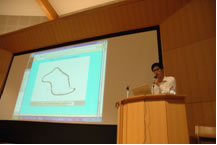 Our research has focused on what pen-based computing can generally work for. For example, there is a system by which hand-written drawings are shaped and adjusted. Geometric figures may be consisted of factors that are horizontal, vertical, symmetry, etc. As the users draw lines and figures, this system applies automatic adjustment and editing to the handwritten drawings. If the user draws a line, which viewed near perfect perpendicular angle, the system will adjust to make a perfect perpendicular, straight line. As such, this system is a tool to create smooth, clean-looking figures by handwriting.
Our research has focused on what pen-based computing can generally work for. For example, there is a system by which hand-written drawings are shaped and adjusted. Geometric figures may be consisted of factors that are horizontal, vertical, symmetry, etc. As the users draw lines and figures, this system applies automatic adjustment and editing to the handwritten drawings. If the user draws a line, which viewed near perfect perpendicular angle, the system will adjust to make a perfect perpendicular, straight line. As such, this system is a tool to create smooth, clean-looking figures by handwriting.
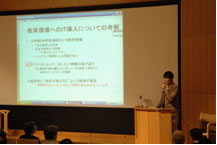 “Kotodama-Lecture”, a presentation tool for teaching in schools, is also under development. This tool is featured with a unique navigation function. Just as the user takes notes on simili paper, the application starts to scroll the paper rather than starting a slide presentation as PowerPoint. This concept is a hybrid of blackboard and slide used for teaching. Since this system provides a seamless representation of edit and presentation activities of the user, and allows the user to present freely. We have asked teachers to try this tool. It has been observed that teachers can use this tool for a variety of purposes.
“Kotodama-Lecture”, a presentation tool for teaching in schools, is also under development. This tool is featured with a unique navigation function. Just as the user takes notes on simili paper, the application starts to scroll the paper rather than starting a slide presentation as PowerPoint. This concept is a hybrid of blackboard and slide used for teaching. Since this system provides a seamless representation of edit and presentation activities of the user, and allows the user to present freely. We have asked teachers to try this tool. It has been observed that teachers can use this tool for a variety of purposes.
Currently, IT is used in classroom mostly to disseminate information to distant locations, such as getting information through web via the network and broadcasting videos. However, we suppose that IT can be used not only as a tool to transfer information but also a new tool for presentation. We explore new styles to present information, such as the automatic creation of clean-looking figures.

